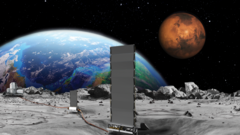Will NASA Launch a Nuclear Reactor on the Moon by 2030?

NASA's Ambitious Moon Nuclear Reactor Plans: A Leap into the Lunar Future
NASA is gearing up to accelerate its plans for constructing a nuclear reactor on the Moon by the year 2030. This initiative is part of a broader endeavor to establish a permanent human presence on the lunar surface. With geopolitical tensions escalating among nations like the United States, China, and Russia, the urgency to harness lunar resources and technology has never been more pronounced. While the prospect of nuclear energy on the Moon presents exciting possibilities, it also raises significant questions regarding feasibility, safety, and the motivations behind such plans.
The Geopolitical Landscape of Lunar Exploration
The race to the Moon is heating up, with multiple nations vying for dominance in space exploration. Politico reports that NASA's acting head has expressed concerns about China's and Russia's ambitions, suggesting that these nations could establish exclusive zones on the Moon. This perspective highlights a competitive edge in lunar exploration, reminiscent of the Cold War space race.
As countries like India and Japan also join the lunar exploration fray, the question arises: how can the U.S. maintain its leadership in this new era of cosmic competition? The emphasis on nuclear power is seen as a strategic move to not only advance scientific endeavors but also to bolster national security in space.
The Call for a Nuclear Reactor
NASA's recent call for proposals from commercial companies aims to develop a nuclear reactor capable of generating at least 100 kilowatts of power. This power output is relatively modest compared to the energy generated by a typical onshore wind turbine, which can produce 2-3 megawatts. However, the unique challenges posed by the lunar environment necessitate innovative solutions for energy generation.
The idea of utilizing nuclear power on the Moon is not entirely novel. In 2022, NASA awarded contracts worth $5 million each to companies tasked with designing a reactor. Moreover, China and Russia have announced plans for an automated nuclear power station on the Moon by 2035, underscoring the international race for lunar energy solutions.
Why Nuclear Power is Essential for Lunar Missions
One of the most compelling arguments for nuclear energy on the Moon is its ability to provide continuous power. A lunar day lasts approximately two Earth weeks, alternating between two weeks of constant sunlight and two weeks of darkness. This cyclical pattern makes solar power alone an unreliable option for sustaining a lunar habitat.
- Reliability: Nuclear reactors can operate continuously, offering a stable power supply for long-term missions.
- High Energy Demand: Establishing a lunar habitat would require megawatt-scale power generation to support life and operations.
- Support for Research: Reliable power is essential for scientific experiments and technological advancements on the lunar surface.
Dr. Sungwoo Lim, a senior lecturer in space applications, underscores the inevitability of nuclear energy for lunar missions, stating, “Building even a modest lunar habitat to accommodate a small crew would demand megawatt-scale power generation.” This sentiment reflects a consensus among scientists that without nuclear power, ambitious lunar missions may struggle to achieve their goals.
Technical Feasibility and Challenges
Experts like Professor Lionel Wilson believe that placing nuclear reactors on the Moon by 2030 is technically feasible, provided that sufficient funding is allocated to the project. There are existing designs for small reactors that could be adapted for lunar conditions. However, the timeline for implementation heavily relies on NASA’s Artemis program, which aims to facilitate human landings on the Moon.
Yet, significant hurdles remain. Safety concerns loom large, particularly regarding the launch of radioactive materials into Earth's atmosphere. Dr. Simeon Barber points out that while it’s possible to secure the necessary licenses for such launches, the risks involved are not to be taken lightly.
Budget Constraints and Political Motivations
The ambitious plans for a lunar nuclear reactor have emerged against a backdrop of budget cuts at NASA. The Trump administration's announcement of a 24% reduction in NASA's budget for 2026 has left many scientists and engineers concerned about the viability of ongoing and future projects, including critical programs such as the Mars Sample Return mission.
Critics argue that the push for nuclear energy on the Moon may be more politically motivated than scientifically driven. Dr. Barber warns that a focus on national interests and territorial claims could overshadow the broader goals of exploration and cooperation in space. “It seems that we're going back into the old first space race days of competition,” he states, emphasizing the need for a unified vision in lunar exploration.
The Artemis Accords and Claims to the Moon
Concerns about territorial claims on the Moon have gained traction in light of the Artemis Accords, an agreement signed in 2020 by seven nations to establish principles for lunar cooperation. These accords include provisions for establishing safety zones around lunar operations, potentially leading to claims of ownership over specific areas of the Moon.
Dr. Barber warns that the establishment of a nuclear reactor could lead to claims of sovereignty over parts of the Moon, reinforcing the notion that nations could assert exclusive rights to specific lunar territories. This scenario raises ethical questions about the ownership of celestial bodies and the future of international cooperation in space.
Logistical Challenges: Getting to the Moon
Despite the technical feasibility of building a nuclear reactor, logistical challenges remain a significant obstacle. NASA's Artemis 3 mission aims to land humans on the Moon in 2027, but setbacks and funding uncertainties have raised questions about the timeline for establishing lunar infrastructure.
Dr. Barber highlights that while having a nuclear power source is crucial, it becomes moot without a reliable means of transporting people and equipment to the Moon. The integration of lunar infrastructure, including habitats and energy sources, must be meticulously planned to ensure the success of future missions.
Conclusion: A New Era of Lunar Exploration
NASA's pursuit of a nuclear reactor on the Moon represents a bold step forward in humanity's quest to explore the cosmos. However, the intersection of scientific ambition, geopolitical considerations, and budgetary constraints presents a complex landscape. As nations navigate the challenges of lunar exploration, the focus must remain on collaboration and shared goals rather than competition and territorial claims.
The journey to establishing a permanent human presence on the Moon is fraught with challenges, yet the potential rewards are immense. As we stand on the brink of a new era in space exploration, the question remains: will we prioritize cooperation over competition, and can we ensure that our ambitions in space benefit all humankind?
FAQs about NASA's Moon Nuclear Reactor Plans
What is NASA's plan for a nuclear reactor on the Moon?
NASA aims to fast-track the development of a nuclear reactor by 2030 to support a permanent human presence on the lunar surface, enhancing energy generation capabilities amid growing international competition.
Why is nuclear energy considered essential for lunar missions?
Nuclear energy provides a continuous power source, which is crucial for sustaining a lunar habitat during prolonged periods of darkness, unlike solar power that is intermittent.
What challenges does NASA face in deploying a nuclear reactor on the Moon?
Major challenges include budget constraints, safety concerns regarding radioactive material launches, and logistical issues related to transporting necessary infrastructure to the Moon.
How do geopolitical tensions impact lunar exploration?
Geopolitical tensions can lead to competition for resources and territorial claims on the Moon, potentially undermining collaborative efforts in space exploration.
As we look to the skies, the unfolding story of lunar exploration raises profound questions about our priorities as a species. Will humanity find a way to work together in the cosmos? #NASA #LunarExploration #NuclearEnergy
Published: 2025-08-05 11:42:08 | Category: wales



